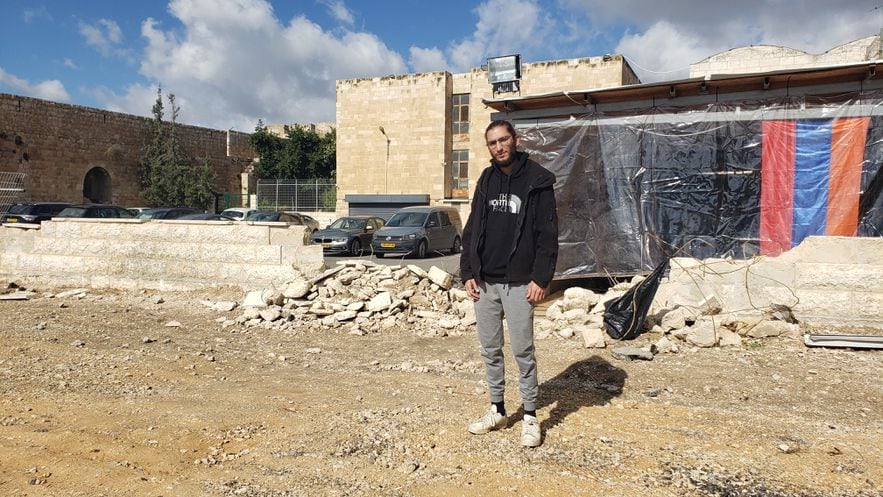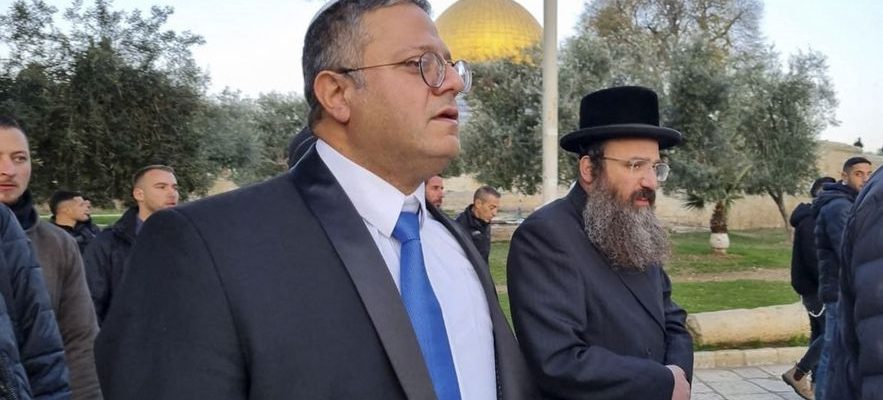Rugby player build, loose shirt, earring and shaved head, without kippah. At first glance, Yoram Ginsburg does not have the classic physique of a madman for God. This Israeli architect, trained at the University of Florence, has nevertheless achieved, in recent years, the status of idol for many ultra-Orthodox Jews who are followers of messianic theories. In his studio in southern Jerusalem, Yoram Ginsburg works on what he describes as “the creation of a paradise on Earth.” Understand: the future of Jerusalem. “It will not only be the most beautiful city in the world, the most connected city or the one with the most fluid functioning, lists the architect. Above all, Jerusalem will be the city of goodness and justice, in the spirit of the Torah [l’enseignement divin]. A symbol of all that is good in this world.”
His project, called “Rebuilding Jerusalem”, does not just improve daily life in the holy city: it multiplies its size tenfold, encompassing other cities such as Ramallah or Bethlehem, in the West Bank. The coastal city of Ashdod would also be absorbed, becoming the port of Jerusalem and the site of construction of a huge international airport, where 5 million tourists could land for the pilgrimage festivals. “I will do everything, during my time on Earth, to ensure that my people are sovereign over their lands,” assures Ginsburg. “This plan will be implemented within thirty years, for the century of Israeli independence. We will be finally home.”
The reconstruction of the Temple, a dangerous obsession
To realize Yoram Ginsburg’s dreams, Israel will therefore have to annex the West Bank, but not only. Supported by rich patrons and tens of thousands of nationalists, the heart of his project consists of erecting the third Temple of Jerusalem on the current Esplanade des Mosques. This sanctuary, built according to the Bible by King Solomon in the 10th century BC, was razed by the Babylonians in – 586 BC, rebuilt fifty years later, then destroyed by the Roman armies in 56. Since then, the reconstruction of the Temple irrigates Jewish religious life: the anniversary of its destruction is marked each year by a day of fasting and, during weddings, the groom breaks a glass in memory of the Temple then promises never to forget Jerusalem.
But the reconstruction of the Temple presupposes the destruction of the Esplanade of Mosques, where the Dome of the Rock stands, whose golden dome illuminates Jerusalem, and especially the al-Aqsa mosque, the third holiest site in Islam after Mecca and Medina . The same sacred summit for two religions, the crux of all conflicts. “Because of al-Aqsa and the Temple Mount, regardless of political circumstances, Jerusalem will forever remain the tectonic plate where civilizations collide,” says lawyer Danny Seidemann, specialist in Israeli-Arab relations.
In the cradle of monotheistic religions, the spiritual goes beyond cold geopolitics. For twenty years and the failure of the Oslo Accords, signed in 1993, new forces have been in motion. “With our rationalist Western filters, we tend to reduce the Israeli-Palestinian conflict to its political-territorial dimension and to underestimate the importance of the religious factor,” says David Khalfa, Israel specialist at the Jean-Jaurès Foundation. Yet , the most mobilized actors, on both sides, are the religious nationalists, whose influence increased with the collapse of the peace process. The disappearance of a diplomatic horizon has raised the question of identity, and in particular religion and its millenarian aspirations, to the fore.”
The Esplanade des Mosques, through its sacred and central character, mobilizes passions. According to rules established with the Jordanians, responsible for its administration, Israeli Jews can go there in limited numbers, at very specific times, but with the formal ban on praying there. In recent years, the messianic movement has caused the number of Jewish visitors to the Temple Mount to explode: there were 8,000 in 2012, more than 50,000 in 2022. Little by little, this massive influx is pushing the limits, with faithful who gather for impromptu prayers on the esplanade or who sing religious songs… Muslims are worried about these advances, seen as provocations, especially since the Israeli government counts in its ranks the supremacist Itamar Ben-Gvir, who has already visited the Esplanade des Mosques three times this year.
By visiting the Esplanade des Mosques on January 3, 2023, Israeli Minister of National Security Itamar Ben-Gvir provoked a wave of indignation and anger.
© / AFP
Hamas used this issue to shed blood, carrying out its “Al-Aqsa Flood” operation on October 7. The leaders of the terrorist group justified the massacre of 1,200 people, mainly civilians, by the Jewish presence on the Esplanade des Mosques. “Even if the whole world remains silent in the face of the events in Al-Quds [le nom arabe de Jérusalem] and in the al-Aqsa mosque, we will not let this happen,” declared Ismaïl Haniyeh, the head of the Hamas political bureau, after October 7. “It is a strategy of Hamas, which is confined in this cramped territory of the Gaza Strip, to open up politically and establish itself as the central actor in the Palestinian national movement, indicates David Khalfa. Hamas uses Jerusalem as a rallying point because it knows its power of attraction and its ability to cross borders.” In a recent poll, a third of Palestinians say they support the Hamas attack “in order to end the violation of al-Aqsa.
The Esplanade des Mosques, much more than a place of prayer for Palestinians
Yazan Risheq knows this power of attraction well, having been born in the old city of Jerusalem thirty years ago. “The name of this Hamas operation, ‘Al-Aqsa Flood’, resonated with all Palestinians, but also with 1.2 billion Muslims around the world, as we are so connected to this holy place,” explains- he said at the wheel of his gray Mitsubishi, in the streets of East Jerusalem. Despite his big brown beard, Yazan prays little but talks a lot. He recounts how, during his childhood, he went to play football on the Esplanade des Mosques with his friends, due to lack of space in the city. A place of life, of meetings, for an entire suffering people. “When the Israelis prevent us from accessing al-Aqsa, as was the case for several weeks after October 7, they know they are playing with fire,” Yazan emphasizes. “They prevent us, the original owners of these lands, to pray in our holy place, but allow settlers to set foot on the ground of al-Aqsa and perform forbidden prayers. This is extremely dangerous.”
The battle for Jerusalem extends far beyond the holy sites. In East Jerusalem, under Arab control until 1967, the fight is played out street by street, house by house, between Palestinian residents and Israeli settlers determined to gain ground in the holy city. There are already more than 200,000 of them who have settled in East Jerusalem. Driving through the Palestinian neighborhood of Sheikh Jarrah, Yazan Risheq points out the few houses that display Israeli flags and denounces the harassment of settlers. “During Ramadan, we set up tables in the streets to break the fast between Palestinians,” says the young father. “At these times, Israeli residents invite other settlers and attack us, under the protection of the “Israeli army. For us, to stay is to resist.” A few streets further, he stops in front of a white tent, abandoned: for several weeks, at the start of the war, the far-right minister Itamar Ben-Gvir had set up his “headquarters” there, in full Palestinian neighborhood. One more provocation to show its determination to control all of the Palestinian territories.

Yazan Risheq, director of Al-Quds Grassroots, an organization that offers sightseeing tours of Jerusalem “with a Palestinian perspective.” Here in East Jerusalem on November 19.
© / The Express
Faced with this push by settlers, Yazan Risheq is leading the fight in his own way, with his organization Al-Quds Grassroots. It offers sightseeing tours of Jerusalem “with a Palestinian perspective” and a claimed political bias. “Our tour is neither traditional nor nice,” underlines the 30-year-old. “It shows the places which expose Israeli policies aimed at expelling Palestinians from Jerusalem, such as the separation walls, urban development, the destruction of homes or the confiscation of land.” In their audience: many students from major American universities, humanitarians and “social justice” movements like Black Lives Matter.
The Armenian community’s struggle for survival
But not all the fighting in Jerusalem revolves around the Israeli-Palestinian conflict. In the old city, very close to the Jaffa Gate, the small Armenian community is struggling in… a parking lot. There are around twenty of them, on this mild November morning, sharing breakfast in their “headquarters”, a cabin made of old wooden beams and sheet metal. A snore comes from the plastic tent set up inside. Valy, black hat, white beard and glass eye, kept watch all night in his parking lot to prevent armed settlers from taking over the place. “We don’t get tired, we stay there even if it rains, even if it snows,” says the fifty-year-old, coffee in hand. “As long as they threaten our land, we don’t move.” Opposite the cabin, covered with a huge Armenian flag, a yellow bulldozer rests near a half-destroyed wall.

Setrag Balian co-founded the SaveTheArc association to protect the heritage of the Armenian quarter of the Old City of Jerusalem. Here on November 21, in front of the “headquarters” against the destruction of their parking lot.
© / The Express
The dispute dates back to July 2021, when the Armenian Patriarchate of Jerusalem agreed to sell these lands, or 25% of the Armenian quarter of the old city, to an Israeli-Australian businessman for only $300,000. The entrepreneur plans to build a luxury hotel on this land. Since then, the former property manager, who signed the contract on the Armenian side, has been defrocked and gone into exile in California. Today, the Armenian Patriarchate denounces this sale with all its might. “A space of this size in the old city of Jerusalem is priceless, it’s the most expensive land in the world,” chokes up Setrag Balian, a young Frenchman born in the old city, who co-founded the SaveTheArq movement. to protect the heritage of the Armenian quarter. So part with it for this sum, then flee abroad… We conclude that there was corruption.”
Pitched battles have been replaying in this parking lot since the Israeli company, escorted by armed settlers and their dogs, attempted to begin forced labor in early November, when international attention was focused on the Gaza Strip. “They thought the Armenian community was very peaceful and fearful,” recalls Setrag, pacing back and forth in the parking lot. parking day and night.” Three days earlier, the company sent 30 people running to occupy the premises. All were quickly chased away.
Beyond this game of cat and mouse, the Armenian community fears that the sale of this land will mark its disappearance from Jerusalem. “The Jewish extremists have already chased the majority of Christians from the old city, they spit on the priests, on the crosses, recalls Setrag Balian. If they start treating us like the Palestinians, it will happen very quickly… We will not We have neither their numbers nor their courage. We are living, literally, an existential crisis.” In their parking lot, the small Armenian group is waging a desperate battle for survival in the ruthless daily life of Jerusalem.
.
